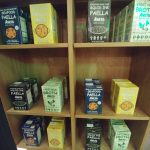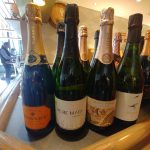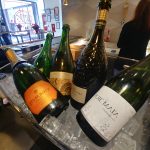

The Trade Commission of Spain held its annual New York City tasting this year in Mercado Little Spain at Hudson Yards, a Spanish marketplace reminiscent of La Boqueria in Barcelona. The venue was an apt choice at which to hold the event; a diverse array of small bites from Iberico ham, breadsticks and Spanish cheese samplers, conveniently gathered in paper cones, and red snapper tapas, to flaky spinach pies, pan tomate and chocolate dipped churros, were liberally distributed to pair with the sparkling, whites, reds, ports and even a rum that were featured at the event.


For those of you who like sparkling wines there were a number of great cava at the event with a quality similar to that of champagne. Like champagne, cava is crafted using the methode traditionnelle, a process whereby a secondary fermentation of the wine takes place in the bottle. This method tends to produce sparkling wines with greater and longer lasting effervescence. However, whereas champagne is made only from Pinot Noir, Chardonnay and Pinot Meunier, cava is produced using Spanish varietals including Macabeo, Xarel·lo and Parellada, in addition to Garnacha, Pinot Noir and Chardonnay.

Cava is primarily produced in Catalonia but it is also produced in vineyards across Penedes, (a region situated between Barcelona and Tarragona), as well as in Aragón, Castilla y León, La Rioja, Basque Country, Valencia, and Navarre.
Cava comprised of Macabeo, Xarel·lo and Parellada is characteristically crisp and has fresh acidity. It tends to exhibit floral, fruity and nutty aromas and lemon, apple and orchard fruit notes. These characteristics do vary of course, depending on the cava, the type and percentage of each grape used, and the production process, as well as the length of time the cava is aged, and so forth. But cava usually exhibits this overall flavor profile because of the unique qualities inherent in each of these three varietals.

Macabeo adds floral aromas and ripe peach, apricot and apple notes.
Xarel.lo offers fresh acidity, delicate herb and scented wood aromas, and citrus fruit, honey and nutty notes.
Parellada provides fragrant citrus fruit notes and acidity.
Spain’s Great Match offered a number of wonderful cava including some that were brut nature, meaning they contain zero to three grams of residual sugar as opposed to brut that contain up to fifteen grams of residual sugar.


Juvé & Camps
Reserva de la Familia Gran Reserva, 2015 ($20.00)
Bodegues Sumarroca
Nuria Claverol Gran Reserva, 2009 ($48.99)
Pere Ventura
Vintage Gran Reserva, 2014 ($62.00)
Parés Baltà
Blanca Cusine’ Gran Reserva 2011 ($40.00)
Casa Sala
Vinyes de Can Sala Cava de Paraje Calificado, 2013 ($60.00)
Can Sala Cava de Paraje Calificado, 2007 ($90.00)
Parxet
Parxet Cuve’e 21, 2017 ($20.00)
Pere Mata
Pere Mata Cupada No. 21, 2016 ($20.00)
Ramon Canals
Mont Paral Vintage 2016 ($18.00)
Alta Alella
Bruant, 2017 ($36.00)
Vilarnau
Reserva Rose’ Delicat ($15.99)
Vins El Cep
Gelida Gran Reserva, 2014 ($19.99)

Be First to Comment